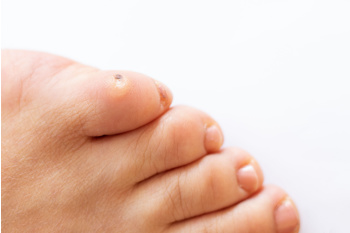
Flat feet occur when the medial longitudinal arch of the foot collapses, causing it to contact or nearly contact the ground. This condition can be present from birth or develop over time. Causes include aging, injury, obesity, or medical conditions that weaken the tendons and ligaments supporting the arch. Some individuals experience no discomfort, while others may have pain, swelling, or fatigue in the feet, ankles, or legs. A podiatrist can evaluate foot structure, identify the underlying cause, and recommend treatment custom orthotics, supportive footwear, and targeted exercises to improve alignment and relieve pain. If you have pain from flat feet, it is suggested that you consult a podiatrist who can offer you effective relief and management tips.
Flatfoot is a condition many people suffer from. If you have flat feet, contact one of our podiatrists from BayCity Associates in Podiatry . Our doctors will treat your foot and ankle needs.
What Are Flat Feet?
Flatfoot is a condition in which the arch of the foot is depressed and the sole of the foot is almost completely in contact with the ground. About 20-30% of the population generally has flat feet because their arches never formed during growth.
Conditions & Problems:
Having flat feet makes it difficult to run or walk because of the stress placed on the ankles.
Alignment – The general alignment of your legs can be disrupted, because the ankles move inward which can cause major discomfort.
Knees – If you have complications with your knees, flat feet can be a contributor to arthritis in that area.
Symptoms
- Pain around the heel or arch area
- Trouble standing on the tip toe
- Swelling around the inside of the ankle
- Flat look to one or both feet
- Having your shoes feel uneven when worn
Treatment
If you are experiencing pain and stress on the foot you may weaken the posterior tibial tendon, which runs around the inside of the ankle.
If you have any questions, please feel free to contact our offices located in Erie, PA and Meadville, PA . We offer the newest diagnostic and treatment technologies for all your foot care needs.

Corns and calluses on the feet are caused by repeated pressure or friction, but they differ in appearance and symptoms. Corns are small, round, and often painful thickened skin areas that develop on toes or other bony prominences. They usually have a hard center surrounded by inflamed skin and can cause sharp pain when pressed. Calluses are larger, broader areas of thickened skin found on the soles or heels. They tend to be less painful but can feel rough or dry. Both conditions are often caused by wearing ill-fitting shoes, abnormal gait, or repeated rubbing. Visually, corns appear as hard, dense spots, while calluses look like rough patches. A podiatrist can diagnose these conditions through examination and identify underlying causes. Treatment may include orthotics, debridement, footwear advice, and addressing gait abnormalities. To prevent pain and further complications, it is suggested that you schedule an appointment with a podiatrist for effective relief and prevention tips.
If you have any concerns regarding your feet and ankles, contact one of our podiatrists of BayCity Associates in Podiatry . Our doctors will treat your foot and ankle needs.
Corns: What Are They? and How Do You Get Rid of Them?
Corns can be described as areas of the skin that have thickened to the point of becoming painful or irritating. They are often layers and layers of the skin that have become dry and rough, and are normally smaller than calluses.
Ways to Prevent Corns
There are many ways to get rid of painful corns such as wearing:
- Well-fitting socks
- Comfortable shoes that are not tight around your foot
- Shoes that offer support
Treating Corns
Treatment of corns involves removing the dead skin that has built up in the specific area of the foot. Consult with Our doctors to determine the best treatment option for your case of corns.
If you have any questions, please feel free to contact our offices located in Erie, PA and Meadville, PA . We offer the newest diagnostic and treatment technologies for all your foot care needs.

Foot pain can develop from a range of conditions that affect the bones, soft tissues, skin, or nerves. One frequent source of foot pain is plantar fasciitis. This is a repetitive stress condition resulting from inflammation of the thick band of tissue that runs along the bottom of the foot. Bunions are another cause, creating a visible bump near the big toe joint that can become painful and swollen. Tendon injuries, such as Achilles tendonitis, cause pain and stiffness near the heel, especially after activity. Nerve compression in the foot, such as tarsal tunnel syndrome, produces tingling, burning, or shooting sensations. Stress fractures, often related to repetitive impact or overuse, lead to localized pain and swelling that worsens with movement. A podiatrist can evaluate the structure of your foot, using imaging to confirm the cause of the pain. If you are experiencing any type of foot pain, it is suggested that you make an appointment with a podiatrist for a diagnosis and treatment options.
Foot Pain
Foot pain can be extremely painful and debilitating. If you have a foot pain, consult with one of our podiatrists from BayCity Associates in Podiatry . Our doctors will assess your condition and provide you with quality foot and ankle treatment.
Causes
Foot pain is a very broad condition that could be caused by one or more ailments. The most common include:
- Bunions
- Hammertoes
- Plantar Fasciitis
- Bone Spurs
- Corns
- Tarsal Tunnel Syndrome
- Ingrown Toenails
- Arthritis (such as Gout, Rheumatoid, and Osteoarthritis)
- Flat Feet
- Injury (from stress fractures, broken toe, foot, ankle, Achilles tendon ruptures, and sprains)
- And more
Diagnosis
To figure out the cause of foot pain, podiatrists utilize several different methods. This can range from simple visual inspections and sensation tests to X-rays and MRI scans. Prior medical history, family medical history, and any recent physical traumatic events will all be taken into consideration for a proper diagnosis.
Treatment
Treatment depends upon the cause of the foot pain. Whether it is resting, staying off the foot, or having surgery; podiatrists have a number of treatment options available for foot pain.
If you have any questions, please feel free to contact our offices located in Erie, PA and Meadville, PA . We offer the newest diagnostic and treatment technologies for all your foot care needs.

